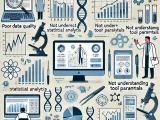
Wearable Devices and Real-Time Data: Pioneering Personalized Healthcare with Omics Integration
July 8, 2025The rise of wearable devices, from smartwatches to biosensors, has ushered in a new era of health monitoring, providing real-time insights into vital signs, physical activity, and even molecular markers. When combined with genomic and omics data, these devices are transforming healthcare by enabling real-time health monitoring, chronic disease management, and personalized wellness plans. By integrating physiological data from wearables with genomic, transcriptomic, proteomic, or metabolomic profiles, researchers and clinicians can create tailored health strategies that are proactive, precise, and patient-centered. This blog explores how wearable devices and real-time data integration are revolutionizing personalized medicine and shaping the future of healthcare.
The Power of Wearable Devices
Wearable devices, such as fitness trackers, smartwatches, and advanced biosensors, have become ubiquitous tools for monitoring health and wellness. Equipped with sensors to track heart rate, blood oxygen levels, sleep patterns, glucose levels, and more, these devices generate continuous streams of real-time data. Advanced wearables can even measure biomarkers like lactate or cortisol, offering deeper insights into physiological states.
The real-time nature of wearable data allows for immediate feedback, empowering individuals to make informed decisions about their health. For example, a smartwatch might alert a user to an irregular heart rhythm, prompting early intervention. However, the true potential of wearables lies in their integration with omics data, which provides a molecular context to physiological measurements, enabling truly personalized healthcare.
Integrating Wearable Data with Omics
Omics technologies—genomics, transcriptomics, proteomics, and metabolomics—provide comprehensive profiles of an individual’s molecular makeup. By combining these profiles with wearable data, researchers and clinicians can:
Personalize Health Insights: Genomic data reveals genetic predispositions, while wearable data tracks how those predispositions manifest in real time, such as elevated blood pressure in individuals with hypertension-related variants.
Monitor Molecular Changes: Wearables equipped with biosensors can measure metabolites or proteins, which, when integrated with metabolomic or proteomic data, provide a dynamic view of health status.
Predict Disease Risk: AI-driven integration of wearable and omics data can predict the onset of diseases like diabetes or cardiovascular conditions before symptoms appear.
For example, a patient with a genetic predisposition to type 2 diabetes (identified through genomics) can use a wearable glucose monitor to track blood sugar levels in real time. AI models integrate these datasets to recommend personalized dietary or exercise interventions, preventing disease progression.
Real-Time Health Monitoring
The ability to collect and analyze data in real time is a game-changer for health monitoring. Wearable devices enable:
Continuous Tracking: Unlike periodic clinical tests, wearables provide ongoing data on vital signs, activity levels, or stress markers, offering a comprehensive view of health trends.
Early Detection: Real-time alerts for anomalies, such as irregular heart rhythms or abnormal glucose spikes, allow for early intervention, reducing the risk of severe outcomes.
Personalized Feedback: By integrating wearable data with omics profiles, individuals receive tailored recommendations, such as adjusting exercise intensity based on genetic markers for muscle recovery.
For instance, wearable devices monitoring heart rate variability (HRV) can be paired with genomic data to identify individuals at risk for arrhythmias, enabling proactive monitoring and lifestyle adjustments.
Chronic Disease Management
Chronic diseases, such as diabetes, hypertension, and heart disease, affect millions worldwide and require ongoing management. Wearable devices, integrated with omics data, are transforming how these conditions are managed:
Diabetes: Continuous glucose monitors (CGMs) track blood sugar levels in real time, while metabolomic data reveals how dietary choices affect glucose metabolism. AI models integrate these datasets to optimize insulin dosing or dietary plans.
Cardiovascular Disease: Wearables monitor blood pressure and heart rate, while proteomic data identifies biomarkers of inflammation or plaque buildup. This combination guides personalized interventions, such as medication adjustments or stress management.
Respiratory Conditions: For diseases like asthma or COPD, wearables track respiratory rates and environmental triggers, while transcriptomic data reveals gene expression changes linked to flare-ups, enabling tailored treatment plans.
For example, a patient with heart failure might use a wearable to monitor fluid retention and heart rate, while proteomic data identifies proteins linked to worsening symptoms. AI integration triggers alerts for medication adjustments, reducing hospital readmissions.
Personalized Wellness Plans
Beyond disease management, wearable devices and omics integration are empowering individuals to optimize their wellness through personalized wellness plans. These plans leverage real-time data and molecular profiles to tailor lifestyle recommendations:
Nutrition: Genomic data identifies dietary sensitivities (e.g., lactose intolerance), while wearables track caloric intake and metabolic responses, enabling personalized meal plans.
Exercise: Wearables monitor fitness metrics like VO2 max, while genomic data reveals muscle fiber composition or recovery rates, guiding tailored workout regimens.
Sleep and Stress: Wearables track sleep patterns and stress markers like cortisol, while metabolomic data identifies pathways affected by poor sleep, informing strategies to improve rest and mental health.
For instance, a wearable might detect poor sleep quality, while transcriptomic analysis reveals upregulated stress response genes. A personalized wellness plan could recommend mindfulness practices or dietary supplements to improve sleep, tailored to the individual’s molecular profile.
Challenges and Ethical Considerations
Despite their promise, wearable devices and omics integration face challenges. Data interoperability—combining wearable data with omics datasets—requires standardized formats and robust computational pipelines. The accuracy of wearable sensors can vary, necessitating validation to ensure reliable health insights. Additionally, the computational demands of AI-driven integration can be a barrier for smaller healthcare systems.
Ethical considerations are critical. Wearable and omics data are highly sensitive, raising privacy concerns. Robust encryption and compliance with regulations like GDPR or HIPAA are essential to protect user data. Equitable access is another issue, as advanced wearables and omics testing may be costly, potentially limiting their benefits to affluent populations.
The Future of Wearable Devices and Omics Integration
As we look to 2025, the integration of wearable devices with omics data is poised to advance further:
Advanced Biosensors: Next-generation wearables will measure a broader range of biomarkers, such as proteins or metabolites, in real time, enhancing integration with omics data.
Edge AI: On-device AI processing will enable real-time analysis of wearable and omics data, reducing latency and enhancing privacy by minimizing cloud reliance.
Population-Scale Studies: Large-scale integration of wearable and omics data will uncover population-level trends, informing public health strategies.
Clinical Adoption: Wearable-omics integration will become routine in clinical settings, guiding real-time treatment decisions for chronic diseases.
Conclusion
The integration of wearable devices with genomic and omics data is revolutionizing healthcare, enabling real-time health monitoring, chronic disease management, and personalized wellness plans. By combining physiological data from wearables with molecular insights from omics, AI-driven approaches are delivering precision healthcare that is proactive and tailored to each individual. While challenges like data privacy and accessibility remain, the future of this integration is bright, promising a world where health is monitored and optimized in real time, empowering individuals to live healthier, longer lives. As wearable technology and omics continue to converge, we are stepping into an era of truly personalized medicine.














